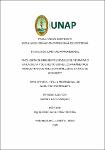Inclusión de diferentes niveles de vitamina de D en la dieta y su efecto sobre los parámetros productivos de pollos parrilleros en fase de acabado
Abstract
El trabajo de investigación se realizó en el galpón de aves del Centro de
Experimentación y Enseñanza Aves, de propiedad de la Facultad de Zootecnia de
la Universidad Nacional Autónoma de Alto Amazonas con el propósito de
determinar la influencia de la inclusión de diferentes niveles de Vitamina D en la
dieta sobre los parámetros productivos de pollos parrilleros. Los parámetros
evaluados fueron Consumo de alimento, Incremento de peso, Conversión
alimenticia, así como el % de mortalidad y Mérito económico. Empleándose 336
pollos machos de línea Cobb, de 3 semanas de edad en la fase de acabado,
distribuidos al azar con un Diseño estadístico Completamente al Azar (DCA), con
cuatro tratamientos y tres repeticiones (28 unidades por repetición en cada
tratamiento), y un grado de confiabilidad (P<0.05). Los tratamientos fueron: T0
(Tratamiento testigo) sin vitamina D; T1: 5 mg de vitamina D; T2: 10 mg de
vitamina D; T3: 15 mg de vitamina D/kg de alimento.
Los resultados fueron: En cuanto al Consumo acumulado de alimento se reportaron
valores de: 196,08; 200,34; 202,6 y 201,49 g para los tratamientos T0, T1, T2 y T3,
respectivamente, no existiendo diferencias estadísticas significativas entre
tratamientos (P< 0.05). Referente al Incremento de peso acumulado se encontró
diferencias estadísticas significativas (P< 0.05) entre tratamientos: 76,99 (T0);
79,95 (T1); 82,43 (T2) y 80,01 (T3) g/día/pollo. Asimismo, referente a la Conversión
alimenticia acumulada se obtuvieron los valores de: 3,0; 2.88; 2,81 y 2.97 para los
tratamientos T0, T1, T2 y T3, correspondientemente, no encontrándose diferencias
estadísticas significativas entre tratamientos (P< 0.05). De la misma forma, el
mayor mérito económico logró S/. 6,20 en el T2, mostrando una mejor rentabilidad.
En conclusión se observa que los tratamientos T2 y T1 alcanzaron mayores
respuestas tanto en el incremento peso con 125,94 y 121,35 g, como en la
conversión alimenticia con valores de 2,81 y 2,91. The research work was carried out in the bird shed of the Bird Experimentation and
Teaching Center, owned by the Faculty of Zootechnics of the National Autonomous
University of Alto Amazonas with the purpose of determining the influence of the
inclusion of different levels of Vitamin D in the diet on the productive parameters
of broiler chickens. The parameters evaluated were Food consumption, Weight
gain, Food conversion, as well as% mortality and Economic merit. Using 336 male
Cobb line chicks, 3 weeks old in the finishing phase, randomly distributed with a
Completely Randomized Statistical Design (DCA), with four treatments and three
repetitions (28 units per repetition in each treatment), and a degree of reliability (P
<0.05). The treatments were: T0 (Control treatment) without vitamin D; T1: 5 mg
of vitamin D; T2: 10 mg of vitamin D; T3: 15 mg of vitamin D/kg of food.
The results were: Regarding cumulative food consumption, values of: 196.08;
200.34; 202.6 and 201.49 g for the treatments T0, T1, T2 and T3, respectively, there
being no significant statistical differences between treatments (P<0.05). Regarding
the accumulated weight gain, significant statistical differences were found (P<0.05)
between treatments: 76.99 (T0); 79.95 (T1); 82.43 (T2) and 80.01 (T3) g/day/
chicken. Likewise, regarding the accumulated food conversion, the values of: 3.0
were obtained; 2.88; 2.81 and 2.97 for the treatments T0, T1, T2 and T3,
correspondingly, no significant statistical differences were found between
treatments (P <0.05). In the same way, the highest economic merit achieved S /.
6.20 in T2, showing better profitability.
In conclusion, it can be seen that the T2 and T1 treatments achieved greater
responses both in the weight increase with 125.94 and 121.35 g, and in the feed
conversion with values of 2.81 and 2.91.
Collections
- Tesis [38]


